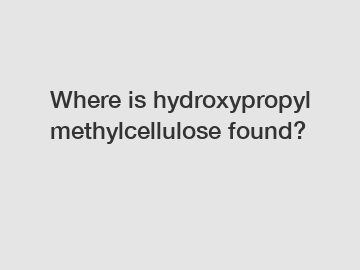Where is hydroxypropyl methylcellulose found?
Hydroxypropyl methylcellulose (HPMC) is found in various industries and products, owing to its versatile properties and wide range of applications. Derived from cellulose, HPMC is a key component used in pharmaceuticals, cosmetics, construction materials, and food products. Let's delve deeper into where HPMC can be found, the reasons behind its prevalence, and its significance and impact on these industries.
In the pharmaceutical industry, HPMC is commonly used as an excipient, which is an inactive substance added to a drug formulation. It serves as a binder, controlling the release of active ingredients, or as a thickener, improving the consistency of liquids and gels. HPMC can be found in various types of medications, including oral tablets, capsules, and topical ointments. The extensive use of HPMC in pharmaceuticals can be attributed to its non-toxicity, stability, and compatibility with other ingredients. Furthermore, its ability to create gel-like structures allows for sustained drug release, enhancing the therapeutic effectiveness of many medications.
In the cosmetics industry, HPMC is used in a wide range of products, such as creams, lotions, shampoos, and mascaras. It functions as a thickening agent, stabilizer, and film-former, ensuring proper texture, improved spreadability, and extended shelf life. Its unique ability to retain moisture also makes it a popular ingredient in moisturizers and personal care products. The safety and gentle nature of HPMC make it a preferred choice for cosmetic manufacturers, as it can be used in products formulated for sensitive skin or for those with specific requirements, such as hypoallergenic or fragrance-free formulations.

The construction industry makes use of HPMC in various applications. It is often used as an additive in cement-based materials, such as tile adhesives, renders, and mortars. HPMC acts as a thickener and water retention agent, improving bonding strength, workability, and open time. It also enhances the flexibility, durability, and resistance to cracking of these materials. Additionally, HPMC improves the resistance to sagging and shrinkage during the curing process. Its presence in construction materials ensures better performance, ease of application, and increased longevity of structures.
In the food industry, HPMC is utilized as a food additive and thickener, providing texture and stability to a wide range of products. It is commonly found in sauces, soups, salad dressings, baked goods, and confectionery items. HPMC allows for increased water retention, preventing syneresis (liquid separation) and maintaining desired consistency. It also acts as a fat replacer, providing a smooth and creamy mouthfeel in low-fat or reduced-calorie food products. Furthermore, HPMC can act as a film-former, maintaining the quality and appearance of fruits and vegetables during storage and transport.
The widespread use of HPMC in various industries can be attributed to its versatility, safety, and functional properties. Its presence enhances the performance, stability, and aesthetic qualities of many products, ultimately improving consumer satisfaction. The ability of HPMC to modify viscosity, control release, retain moisture, and improve texture makes it an invaluable component in pharmaceuticals, cosmetics, construction materials, and food products. By understanding where HPMC is found and its significance, we can better appreciate its impact on the industries that rely on its exceptional properties.
For more hpmc manufacturer, hpmc powder factory, gypsum retarder chemicalinformation, please contact us. We will provide professional answers.

Comments